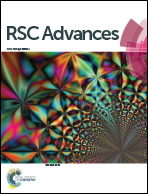Fabricating conductive poly(ethylene terephthalate) nonwoven fabrics using an aqueous dispersion of reduced graphene oxide as a sheet dyestuff
Abstract
A simple one-step dyeing-like approach was presented for fabricating conductive poly(ethylene terephthalate) (PET) nonwoven fabrics using reduced graphene oxide (rGO) as a sheet dyestuff. Using polyurethane (PU) as a middle adhesive layer, the rGO can be adsorbed and immobilized on the surface of the PET fabrics due to the strong attraction between the two adjacent components. As a result, conductive fabrics with high structural stability were successfully prepared in an aqueous dispersion of rGO. The as-prepared composite fabrics were characterized using scanning electron microscopy, Fourier transform infrared spectroscopy, Raman spectroscopy, and thermogravimetric analysis. The effects of the weight fraction of the rGO on the morphology, structure and electrical properties of the composite fabrics were discussed. These composite fabrics exhibited a rather low electrical percolation threshold due to the homogeneous coverage of graphene sheets on the surface of the PET nonwoven fabrics, and the highest conductivity was about 2.0 × 10−5 S sq−1, ensuring feasibility to manufacture efficient heating elements. Importantly, the direct use of an aqueous dispersion of rGO in dyeing opens up new possibilities for the mass production of graphene-based innovative fabrics.


 Please wait while we load your content...
Please wait while we load your content...